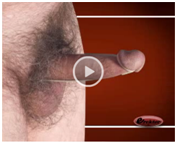Politano-Leadbetter ureteric reimplantation (step by step operation series)
In this series we present an easy illustration to different operative techniques in urology
INTRODUCTION
The many antireflux procedures currently in use have a success rate of 95% . they all attempt to create a submucosal tunnel which is four times longer than the width of the ureter being reimplanted. Of the many intra- and extravesical techniques in use, the Politano-Leadbetter, Lich-Gregoir and Cohen have gained the greatest popularity over the past four decades.
The main indication for this procedure is bilateral reflux, which can be surgically corrected at one session . It creates a neo-orifice in an anatomically correct position, which is easily accessible for endourological manipulations . There is no risk of lesions to the pelvic ganglion, with persistent neurogenic bladder dysfunction, if the extravesical preparation is made close to the ureter in the layer of the meso-ureter.
INDICATIONS
• Uncomplicated vesico-renal reflux grade II–V.
• Before puberty in undilated single or double systems.
• Bilateral reflux.
PREOPERATIVE DIAGNOSTIC PROCEDURES
• Urine culture.
• Kidney and bladder ultrasonography, exclusion of residual urine.
•Voiding cystogram.
• MAG 3 clearance.
• Exclude ureteric obstruction
STEP 1
Pfannenstiel incision. Longitudinal incision of rectus fascia.
STEP 2
Longitudinal bladder dome incision.
STEP 3
Bilateral fixation of the bladder wall at rectus fascia. Insertion and fixation of an ureteric stent.
STEP 4
Circumferential incision of the ureteric orifice.
STEP 5
Distal ureterolysis; the preparation is made close to the ureter in the layer of the meso-ureter.
STEP 6
Transvesical mobilization of the adherent peritoneum from the distal ureter using a Langenbeck retractor for better visualization.
STEP 7
Transvesical insertion of an Overholt close to the bladder wall 3 cm above the old orifice incision of the bladder mucosa to create a neo-hiatus.
STEP 8
After preparation of a wide neo-hiatus, grasping of a free suture as a guide rail for the ureter
STEP 9
Retraction of one suture end into the bladder. Fixation with the stay suture of the ureteric orifice after stent removal
STEP 10
Passage of the extravesically mobilized ureter through the wide neo-hiatus pulling at the free suture end intravesically.
STEP 11
Transvesical transposition of the distal ureter. Submucosal tunnel preparation from the old to the new hiatus
STEP 12
Closure of the bladder wall defect (former position of the old orifice) using three sutures.
STEP 13
Submucosal transposition of the distal ureter.
STEP 14
Fixation of the orifice at initial position after resection of a dysplastic ureteric segment. Closure of the bladder mucosa over the reimplanted ureter.
STEP 15
Wound closure. Drainage, ureteric stent and two cystostomies in place
POSTOPERATIVE CARE
• Remove the wound drain on day 3.
• Remove the first cystostomy when urine is clear on day 3–5.
• Remove the first ureteric stent after 8 days, the second after 9 days together with the second cystostomy.
• Kidney ultrasonography after removing the stents.
• Antibiotic treatment (cephalosporin) during stenting.
• Antibiotic prophylaxis is given for 2 weeks in uncomplicated cases, otherwise for 3 months.
• Analgesic therapy



















